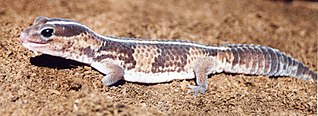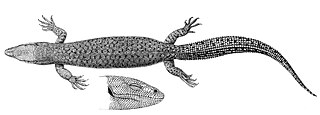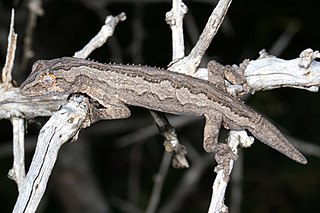
The blue-tailed day gecko is a diurnal species of gecko, a lizard in the family Gekkonidae. The species is endemic to the island Mauritius. It typically inhabits warm and humid places and dwells on different trees and bushes.

The Mauritius lowland forest day gecko, also known commonly as Guimbeau's day gecko and the orange-spotted day gecko, is a diurnal species of gecko, a lizard in the family Gekkonidae. The species is native to the western coast of Mauritius and typically inhabits large trees. The Mauritius lowland forest day gecko feeds on insects and nectar.

Teratoscincus is a genus of geckos commonly referred to as wonder geckos or frog-eyed geckos; it is the only genus within the subfamily Teratoscincinae of the family Sphaerodactylidae. Species in the genus Teratoscincus are found from the Arabian Peninsula in Qatar, the United Arab Emirates, and Oman, west across southern Asia in Iran, Afghanistan, and Pakistan, north to Russia, Kazakhstan, Turkmenistan, Uzbekistan, and Tajikistan to Mongolia and China. The genus consists of nine species.

A prehensile tail is the tail of an animal that has adapted to grasp or hold objects. Fully prehensile tails can be used to hold and manipulate objects, and in particular to aid arboreal creatures in finding and eating food in the trees. If the tail cannot be used for this it is considered only partially prehensile; such tails are often used to anchor an animal's body to dangle from a branch, or as an aid for climbing. The term prehensile means "able to grasp".

The African fat-tailed gecko or fat-tail gecko is a ground-dwelling species of gecko from West Africa and Cameroon.

The flat-tailed house gecko, also known as the frilled house gecko or Asian house gecko, is a species of Gekkonidae native to southeastern and southern Asia. The species is sometimes classified under the genus Cosymbotus.

Christinus marmoratus, also known as marbled gecko or southern marbled gecko, is a species of Gekkonidae (gecko) native to southern mainland of Australia, from Victoria to Western Australia. The species is well adapted to a variety of habitats, including city dwellings..

The short-tailed pygmy monitor is the second smallest living monitor lizard in the world with a maximum length of 25 cm.

The stripe-tailed goanna, also known as the line-tailed pygmy monitor is a semi-arboreal species of monitor lizard native to Western Australia.

Mesobuthus eupeus is a polymorphic scorpion species belonging to the well-known family Buthidae. Commonly known as the lesser Asian scorpion or the mottled scorpion. It is thought to be the most widely dispersed species of the genus Mesobuthus, perhaps even of the family Buthidae.
Lucasium byrnei, also known commonly as the gibber gecko, Byrne's gecko, and the pink-blotched gecko, is a species of small, nocturnal lizard in the family Diplodactylidae. The species is endemic to Australia.

Phrynocephalus versicolor, the Tuvan toad-headed agama, is a species of agamid lizard found in desert areas of China and Mongolia. It was first described by the Russian herpetologist Alexander Strauch, director of the Zoological Museum at the Imperial Academy of Sciences at St. Petersburg.

Strophurus intermedius, also known commonly as the eastern spiny-tailed gecko or the southern spiny-tailed gecko, is a species of lizard in the family Diplodactylidae. The species is endemic to semi-arid regions of Australia in New South Wales, Northern Territory, South Australia, Victoria and Western Australia, in mallee shrubland and woodland habitats.

Chondrodactylus angulifer, also known as the common giant ground gecko, the South African ground gecko, or the Namib sand gecko, is a species of gecko, a lizard in the family Gekkonidae. The species is endemic to southern Africa.

Paroedura maingoka, the scorpion leaf-toed gecko, is a species of lizard in the family Gekkonidae. It is endemic to southwest Madagascar, where it occurs on rock outcrops in dry forests and scrubland. It is a nocturnal species, emerging to feed at night.

Teratoscincus scincus, commonly referred to as the common wonder gecko or the frog-eyed gecko, is a species of lizard in the family Sphaerodactylidae. The species is native to arid parts of Asia and has special adaptations which suit it to desert life.

Teratoscincus bedriagai, also known commonly as Bedraiga's wonder gecko or Bedriaga's plate-tailed gecko, is a small species of lizard in the family Sphaerodactylidae. The species is native to Central and Western Asia.
Przewalski's wonder gecko is a species of lizard in the family Sphaerodactylidae. The species is endemic to East Asia.

Phrynocephalus vlangalii, also known as the Qinghai toad-headed agama, the Ching Hai toadhead agama, the Pylzow's toadhead agama, or gecko toadhead agama, is a species of viviparous agamid lizard endemic to the Tibetan Plateau in China. This lizard lives in burrows at high elevations of 2,000 to 4,600 meters. It is also known for its aggression, especially between females during mating season since females usually only have one mate. P. vlangalii curls its tail and shows a patch on its underbelly as defense displays against conspecifics. This lizard also has a variety of gut microbiota that help perform metabolic and biological functions depending on the altitude at which the lizard lives.

Paroedura rennerae is a species of lizards in the family of the Gekkonidae. Members of this species were formerly assigned to Paroedura bastardi, but a study in 2021 found that they represent a separate species within the species complex. It is endemic to Madagascar, where it occurs in a variety of habitats.






















